The Ancient Roman Fountains, whether public or private, were striking features in the ancient Roman cities. The ancient Romans had great regard for running water. Water symbolized freshness, and its ever-changing nature was used to memorialize and immortalize great men and their noble deeds.
According to records from the 3rd century CE, there were 1,423 drinking fountains in the ancient city of Rome, today there are more than 2,000.
Originally, Rome’s fountains relied on gravity, and the source of the aqueduct had to be higher than the fountain itself. The complex calculations could often be challenging for the architects but were essential as this determined how high the fountain could shoot water. It wasn’t until the Renaissance that fountains would become a focus for the city again, this was thanks to Rome’s growing population.
Ancient Roman Fountains

The Fountains of St. Peter’s Square
Intricately sculptured fountains gave ancient Rome a charm. It shows how much the ancient Roman cities owe to the charm and enchantment of gushing and sprinkling waters.
The ancient Roman fountains gathered invited admiration and praise from people and archaeologists from across the world
- Roman Public Fountains

The ancient Roman public fountains were numerous and were designed in either of the two ways mentioned. Firstly, as a huge basin of water called Lacus, or secondly as spouting jets known as Calientes. In some cases, the two designs were combined and blended with marble columns and statues.
- Roman Private Fountains

Villa d'Este -Tivoli, Rome
The ancient Roman private fountains also existed in great numbers, particularly in the courts and gardens of the ancient Roman houses. They were designed with a large variety of colored marbles and porphyries or sometimes decorated with bronze statues.
The water sometimes emanated from fishes, shells, or other sea objects or sometimes from lions’ heads in wall niches lined with mosaics, as the fountain at Pompeii. The most popular and sought-after fountains of ancient Rome by tourists and archaeologists are mentioned below.
- Fountain of Triton
The Ancient Roman Fountain of Triton was made in Travertine by Gian Lorenzo Bernini in 1642. The fountain is undoubtedly one of the most beautiful fountains in the city. It represents a sea monster, half human and half fish sitting on the valves of an open shell.

Bernini’s Triton Fountain is one of the most overlooked yet most beautiful fountains in Rome
Located in the center of the busy Piazza Barberini, between Via Veneto and Via del Tritone, the fountain doesn’t get as many visitors as more monumental ones such as the Trevi Fountain or the Fountain of the Four Rivers in Piazza Navona.
However, it is a must-see for Bernini lovers and an interesting fountain to notice if you are in the Trevi district.
- Trevi Fountain
The ancient Roman Trevi Fountain was built between 1732 and 1762 as a ding to a project by Nicola Salvi. The Trevi Fountain is one of ancient Rome’s most famous landmarks and underscores the role of fountains in Rome’s urban landscape.

The Trevi Fountain was believed to be a large monument set against a pre-existing building. The architectural and decorative elements of the fountain scenically define the course of the water that runs down as a waterfall and collects in the large basin representing the sea.
- Roman Fountain of Books

Next, the ancient Roman fountain of Books was built near the complex of Sant’Ivo Alla Sapienza. Which was at one time the seat of the University of Rome. It is decorated with a deer’s head and three volumes.
- Fountain of Porter
A male figure with a badly-damaged face holds a barrel in his hands, out of which flows a stream of water creating a little fountain: it is the so-called Fountain of the Porter leaning against the wall of Palazzo De Carolis on Via Lata, originally cited on Via del Corso.
The ancient Roman fountain of the Porter is an illustration of one of Rome’s talking fountains. For ages, the political satires, popularly known as Pasquinades, written by the ancient Romans to ridicule the authorities, were attached to these fountains and hence the importance attached to them
Rome is a city of water, and the pride the ancients took in its aqueducts is as applicable today as it was 2,000 years ago. Delicious, ubiquitous drinking water is a welcome feature any time of year. But visit Rome in the height of summer, when the heat can exceed 40 degrees Celsius (104 degrees Fahrenheit), and you’ll appreciate the fountains even more.
Watch the video below for more information about: ancient roman fountains